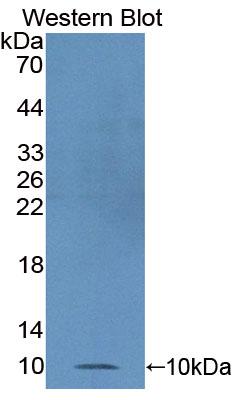Polyclonal Antibody to Macrophage Inflammatory Protein 1 Alpha (MIP1a) 

CCL3; MIP1-A; SCYA3; Chemokine C-C-Motif Ligand 3; Small Inducible Cytokine A3; Homologous To Mouse Mip-1a; Tonsillar Lymphocyte LD78 Alpha Protein
Overview
Properties
- Product No.PAA092Hu06
- Organism SpeciesHomo sapiens (Human) Same name, Different species.
- ApplicationsWB; IHC; ICC; IP.
If the antibody is used in flow cytometry, please check FCM antibodies.
Research use only - DownloadInstruction Manual
- CategoryCytokineInfection immunity
- SourcePolyclonal antibody preparation, Host Rabbit
- Ig Type IgG, Potency n/a
- PurificationAntigen-specific affinity chromatography followed by Protein A affinity chromatography
- LabelNone
- Immunogen n/a
- Buffer FormulationPBS, pH7.4, containing 0.02% NaN3, 50% glycerol.
- TraitsLiquid, Concentration 500µg/mL
Sign into your account
Share a new citation as an author
Upload your experimental result
Review

Contact us
Please fill in the blank.
Specifity
The antibody is a rabbit polyclonal antibody raised against MIP1a. It has been selected for its ability to recognize MIP1a in immunohistochemical staining and western blotting.
Usage
Western blotting: 0.2-2µg/mL;1:250-2500
Immunohistochemistry: 5-20µg/mL;1:25-100
Immunocytochemistry: 5-20µg/mL;1:25-100
Optimal working dilutions must be determined by end user.
Storage
Store at 4°C for frequent use. Stored at -20°C in a manual defrost freezer for two year without detectable loss of activity. Avoid repeated freeze-thaw cycles.
Stability
The thermal stability is described by the loss rate. The loss rate was determined by accelerated thermal degradation test, that is, incubate the protein at 37°C for 48h, and no obvious degradation and precipitation were observed. The loss rate is less than 5% within the expiration date under appropriate storage condition.
Giveaways
Increment services
-
 Antibody Labeling Customized Service
Antibody Labeling Customized Service
-
 Protein A/G Purification Column
Protein A/G Purification Column
-
 Staining Solution for Cells and Tissue
Staining Solution for Cells and Tissue
-
 Positive Control for Antibody
Positive Control for Antibody
-
 Tissue/Sections Customized Service
Tissue/Sections Customized Service
-
 Phosphorylated Antibody Customized Service
Phosphorylated Antibody Customized Service
-
 Western Blot (WB) Experiment Service
Western Blot (WB) Experiment Service
-
 Immunohistochemistry (IHC) Experiment Service
Immunohistochemistry (IHC) Experiment Service
-
 Immunocytochemistry (ICC) Experiment Service
Immunocytochemistry (ICC) Experiment Service
-
 Flow Cytometry (FCM) Experiment Service
Flow Cytometry (FCM) Experiment Service
-
 Immunoprecipitation (IP) Experiment Service
Immunoprecipitation (IP) Experiment Service
-
 Immunofluorescence (IF) Experiment Service
Immunofluorescence (IF) Experiment Service
-
 Buffer
Buffer
-
 DAB Chromogen Kit
DAB Chromogen Kit
-
 SABC Kit
SABC Kit
-
 Long-arm Biotin Labeling Kit
Long-arm Biotin Labeling Kit
-
 Real Time PCR Experimental Service
Real Time PCR Experimental Service
Citations
- Age influence on hypersensitivity pneumonitis induced in mice by exposure to Pantoea agglomeransPubmed: 24044680
- The Transcriptional Foundations of Sp110-mediated Macrophage (RAW264. 7) Resistance to Mycobacterium tuberculosis H37RaPubmed:26912204
- CIRCULATING MACROPHAGE INFLAMMATORY PROTEIN-1 ALPHA (MIP1-Α) AS A POTENTIAL BIOMARKER FOR THE DIAGNOSIS OF PATIENTS WITH …57e97ac908aeb34bc08fd41a.pdf
- Role of Gut-Derived Endotoxin on Type I Collagen Production in the Rat Pancreas after Chronic Alcohol Exposure pubmed:29121396
- Changes in the concentrations of inflammatory and oxidative status biomediators (MIP-1 α, PMN elastase, MDA, and IL-12) in depressed patients with and without posttraumatic stress disorder10.1016/j.pharep.2017.08.008
- Molybdenum disulfide/graphene oxide nanocomposites show favorable lung targeting and enhanced drug loading/tumor-killing efficacy with improved …Articles:am2017225
- Therapeutic Potential of Pien Tze Huang on Experimental Autoimmune Encephalomyelitis RatPubmed:29682587
- Cathelicidin LL-37 affects surface and intracellular Toll-like receptor expression in tissue mast cellsPubmed:29670923
- Changes in the concentrations of inflammatory and oxidative status biomediators (MIP-1 α, PMN elastase, MDA, and IL-12) in depressed patients with and without …Pubmed:29339257
- CQPC06 Activity Prevents Dextran Sulfate Sodium‐Induced Colitis by Regulating the IL‐8 PathwayDoi: 10.1111/1750-3841.14346
- The anti-inflammatory and anti-oxidative effects of conbercept in treatment of macular edema secondary to retinal vein occlusionPubmed: 30558792
- Intravitreal conbercept improves outcome of proliferative diabetic retinopathy through inhibiting inflammation and oxidative stressPubmed: 33227274
- α-Galactosylceramide and its analog OCH differentially affect the pathogenesis of ISO-induced cardiac injury in micePubmed: 32973325
- PIGU promotes hepatocellular carcinoma progression through activating NF-κB pathway and increasing immune escapePubmed: 32971102
- A vaccine-based nanosystem for initiating innate immunity and improving tumor immunotherapyPubmed: 32332752
- PDIA6 promotes pancreatic cancer progression and immune escape through CSN5-mediated deubiquitination of β-catenin and PD-L134325342






